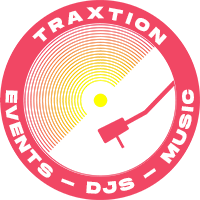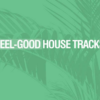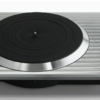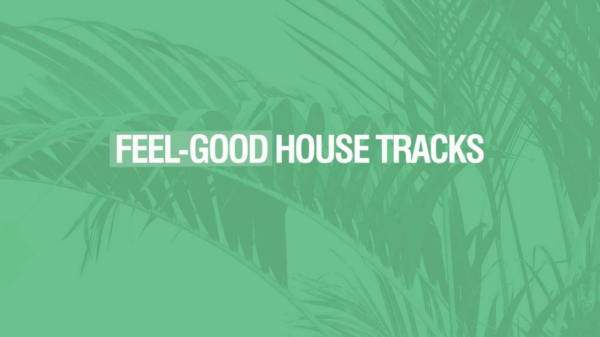Thanks to new technology, disco mutated into something thrillingly new. As one song on this list goes: “Gotta have house music all night long”
Melding the strut of disco with an electronic pulse, house music took its name from a short-lived Chicago nightclub called the Warehouse. Opened in 1977, the three storey venue booked Frankie Knuckles – a disco DJ from New York – as its main resident, and the Warehouse became a home for many of the marginalised people who first adopted disco a decade earlier. Armed with relatively new technology – drum machines, synthesisers, and new audio editing techniques – DJs and producers picked up where Giorgio Moroder and Donna Summer left off with the robotic disco smash ‘I Feel Love’, and then rolled with it.
Detroit has a reputation for spearheading techno, and when genre pioneer Juan Atkins formed Model 500, he helped to take house in a harsher, more robotic direction. Long before techno was established, his track ‘NO UFOs’ – with its clear, early hints of the genre he later helped to found – became a regular fixture in Chicago clubs, and when UK label heads flocked to seek out house music, they also scheduled a pitstop in Detroit. Not just a first-rate house track, ‘NO UFOs’ also paved the way for an entire other genre to find its own spotlight: a few years after its release, the compilation album ‘Techno: The New Dance Sound of Detroit’ was released, and another movement was born.
The French house outfit Stardust might only have one track to their name, but man – they were not messing about with ‘Music Sounds Better With You’. A collaboration between Daft Punk’s Thomas Bangalter, electro musician Alan Braxe, and Benjamin Diamond – who played in punk band Chicken Pox – the track samples the sunny, pulsing melody of Chaka Khan’s ‘Fate’, and takes house into heady, euro-dance territory. Created as the trio were playing at Paris’ Rex Club, Diamond improvised the vocals during the set, and Stardust went into the studio to record the very next day.
Despite being offered £3 million to record a Stardust album, the three artists never collaborated together again, leaving a single smash hit behind in their wake.
Steve “Silk” Hurley first began to master mixing by playing parties for high school kids, originally transitioning between records by moving a microphone from one turntable to the other. Gradually the DJ got his hands on more sophisticated equipment, and bagged a residency spot at Chicago’s Candy Store; soon he began working on his own original tracks to stand out from the crowd.
‘Music is the Key’ was his first release in 1985, released under the moniker J.M. Silk. Legend has it that the alter-ego wasn’t his first choice, with fellow Chicagoan Farley Jackmaster Funk pinching his first choice Steve “Jackmaster” Silk.
Growing up in Manchester, 808 State’s Graham Massey had an eclectic range of interests: astronomy, prog rock, cutting edge music tech and the soulful classics of Stevie Wonder. As a teenager he spent his free time doodling diagrams of new synths and tinkering with cheap instruments from Woolworth’s for hours. All of this comes to a head on ‘Pacific State’.
808 State originally started working on ‘Pacific State’ ahead of a planned John Peel session – which was later canned because the group refused to go and record on station property. “We didn’t fancy working with BBC engineers and going back to that old‑fashioned protocol,” Massey told the magazine Sound on Sound. “It’s not the way we made records.” Instead, their methods were laid back and improvisational, with an open-door policy in the studio. Alongside recording, the group also partied at Manchester’s Haçienda nightclub, and fell head over heels for Marshall Jefferson’s tropical-tinged epic ‘Open Your Eyes’. And so they pinched some of the Chicago house track’s chords, slapped a honking great saxophone solo, some bird sounds and a fidgety 909 drum beat over the top, and an early ’90s house classic was born.
Stick on ‘Passion’ and you’ll immediately find yourself transported to hedonistic, early ’90s Ibiza, – this euphoric dance track is the sensation of a club of revellers raising their arms as the sun comes up, bottled. Its skittering drum beat, combined with bright bursts of piano set down the template for much of the progressive house that followed it: the original Naked mix samples The Prodigy’s ‘Everybody In The Place’, and takes its abrasive attack to a breezier place.
Born on Chicago’s South Side, Chip E’s introduction to dance parties arrived when he was eleven, and wangled a school assignment taking photographs at downtown venue the Loft. “There were all these people sweating and dancing and having fun and I thought, “Wow, this is something I really wanna be a part of.” From that point on I was hooked,” he told Red Bull Music Academy. Later, he picked up mixing, and began DJing at high school parties; and right before making ‘Time To Jack’ he started working at the label Importes Records. “We found that if we put up signs that said, “As heard at the Warehouse,” the records would fly out of the racks,” he added.
Through working at Importes, Chip E got to know the likes of Frankie Knuckles, Jesse Saunders and Ron Hardy, and in 1983 he poured his rich knowledge of Chicago’s dance scene directly into ‘Time To Jack’ – the title references a dance move that was dominating the city’s clubs.
An early-doors member of 808 State, Gerald Simpson – aka. A Guy Called Gerald – went onto become a UK house innovator after leaving the group. Towards the end, Simpson would nick the group’s drum machine, and sneak off to do his own thing; his seminal acid house track ‘Voodoo Ray’ came from those secret sessions. It went on to become a staple anthem of the Haçienda.
Rather than partying at Manchester’s most infamous club, experiencing a kind of ecstatic epiphany and racing home to recreate it in musical form, A Guy Called Gerald made something entirely new, drawing from all the music he loved and the black club scene: Jamaican pop, Trojan Records’ reggae, ska, gospel, jazz-funk, and the soundsystem parties in the city’s Moss Side all influenced ‘Voodoo Ray’ in some form. It’s one of the most influential UK acid house tracks going.
Powered by an unmistakable lead hook – made using the Korg M1 piano and organ – ‘Show Me Love’ was perhaps one of house music’s biggest crossover hits, quickly becoming a mainstay of clubby radio stations in the ’90s. Fusing house’s synthetic pulse with the gutsy heart of NYC disco, Robin S. recorded that belting vocal while suffering from the flu.
The track’s influence on contemporary dance music is clear to hear, and in 2020 Robin S’s biggest hit enjoyed an unlikely but genius second wind after comedy Twitter account @loveofhuns mashed it up with a video of a Scouse woman named Sandra searching for her African grey parrot. All together now in your best diva vocal: “CHANNNNEEEELLLLL!”
By the late ’80s, a new offshoot of house was also gripping New York, and in 1989, Mark Finkelstein and Gladys Pizarro founded the label Strictly Rhythm. The label championed the likes of Todd Terry, Erick Morillo, and DJ Pierre – as well as Louie Vega and Kenny “Dope” Gonzalez.
Vega and Kenny Dope are best known for the dance duo Masters At Work, and Hardrive was something of a side-project. Their EP title-track ‘Deep Inside’ isn’t just representative of Strictly Rhythm; the release as a whole quite features a solid chunk of talent from the label. Barbara Tucker is unstoppable on vocals, house DJ and labelmate Maurice Joshua is a co-producer, while Morillo engineered it – and it’s a choppy, mangled slab of Vega and Dope at the peak of their joint powers.
Lil Louis – aka Marvin Burns – threw parties of mythical status at Chicago venues such as The Bismarck Hotel, and regularly played Medusa’s. Opened after the city’s Warehouse closed down, Medusa’s played an eclectic mix of house, new-wave, and industrial, and attracted a varied crowd ranging from punk kids to sharply-dressed house-heads.
And ‘French Kiss’ is perhaps his best known hit. One of the most NSFW acid-house anthems going, it takes the unusual route of slowing down to a stop before erupting into a cacophony of orgasmic moans that gather pace again like a jackhammer. The 10-minute erotic epic has endured to the present, and keen-eared Robyn fans might even notice a sample of ‘French Kiss’ on her latest album ‘Honey’s clubbiest moment ‘Between the Lines’.
Inspired by the melodic drive of choice cuts by Chaka Khan and Evelyn ‘Champagne’ King, Inner City’s Kevin Saunderson first dreamt up ‘Good Life’ to bring a slice of disco groove to Detroit techno.
After laying down the instrumentals at home, he headed into the studio with Chicago-based collaborator Paris Grey – a day later, it was finished. “Let me take you to a place I know you want to go,” Grey sings, before a thumping Roland TR-909 drum machine pummels into life. The 1988 house track quickly hopped the Atlantic and grew into a global mega-hit; it was a staple of Manchester’s Hacienda nightclub.
Its escapist sentiment proved infectious. “I’d grown up singing in church and had been a girl scout and a cheerleader, so lyrics about positive thinking and good vibes came naturally,” Grey told The Guardian last year. “The ’80s had been very hard for people: ‘Good Life’… tapped into a feeling that things were getting better.”
People have written entire essays about what on earth Cajmere was getting at when he announced “it’s time for the percolator” atop cartoonish fire alarms and a possessed wobble-board. Released in 1992, this puzzling Chicago house classic could either be about the meaning of life, or making an espresso. Either way, Curtis A. Jones’ best known track is both harsh and playful at the same time – and his work under the name Green Velvet takes his surreal leanings even further.
The stabs of piano fuelling CeCe Rogers’ ‘Someday’ are unmistakable, and this 1987 track – produced by Marshall Jefferson – didn’t just have an enormous influence on the direction of dance music. It also encapsulates the sense of collectivism that draws people to clubs in the first place and, more poignantly, the struggles many of them overcome. “If we could just open our eyes / we could make our world a Paradise,” she sings to a Utopia that hasn’t yet arrived; the house track also makes references the South African apartheid.
The power of Rogers performance caught the eye of Atlantic, and they soon signed her – ’Someday’ became the first house track to come out on a major label.
When Phuture created the psych-drenched ‘Acid Tracks’ – a meandering dance epic that smashes well through the 10-minute mark – they knew that there was only one DJ in Chicago daring enough to take a punt on it. The Music Box’s Ron Hardy had a reputation for clashing together wildly experimental ideas, and was pioneering a harsh, relentless offshoot of house – and the first two times he played ‘Acid Tracks’ the dancefloor cleared to resemble a ghost town. When he dropped it for a third time on the same night, it erupted. “People just went crazy in that place,” recalled Phuture’s DJ Pierre, speaking to Red Bull Music Academy. “They didn’t even know what to do… They were jumping up and down. I will never forget this guy—he was lying on his back and kicking his legs up in the air, and I was like, ‘What’s he doing?’ I’ve never seen anyone react to a song like that.”
The track quickly became synonymous with Hardy – party-goers in Chicago soon nicknamed it Ron Hardy’s Acid Track – and revellers went to great lengths to get their hands on a copy, smuggling cassette recorders into Music Box to bootleg it. Excitable people even rushed to tell members of Phuture about the hot new track they’d discovered, without realising they were speaking to its creators. “I pulled out my cassette tape, I said, “I’ll prove it to you!”” DJ Pierre told The Fader. “I always had my cassette tape with me, and I put it in, and then we played it and he heard the track from the beginning and he realized that we made it. I said, since everybody knows that’s the acid track, we’re just going to change the title to just ‘Acid Tracks’”
Larry Heard’s former Infinity bandmate Adonis was 19 when he made ‘No Way Back’ – and according to rough estimates, the Trax Records release went on to sell 100,000 copies. Classically trained, Adonis studied at Chicago’s American Conservatory of Music, and was a fan of P-Funk heads like Parliament and Funkadelic. That psych influence is clear to see in his acid-house hit.
Built on minimal foundations, an ominous vocal hook (“Release my soul / I’ve lost control / Too far gone / Ain’t no way back”) lends the influential track a certain dystopian menace. 34 years on, ‘No Way Back’ still sounds positively futuristic.
The same year that Chicagoan producer Steve “Silk” Hurley took Isaac Hayes’ soul song ‘I Can’t Turn Around’ and twisted it into a percussive dance track, J.M. Silk’s then-housemate Farley Keith reckoned he could do even better. And so he enlisted house pioneer Jesse Saunder and vocalist Darryl Pandy for the task.
With a mighty vocal range of six-and-a-half octaves and a background that spanned from opera, broadway and gospel, Pandy’s genre-blending approach was accidentally perfect for house music. When ‘Love Can’t Turn Around’ made it to Top of the Pops in the UK, he rose to the occasion with a retina-searingly glittery shirt and high notes to rival those of whistle-voiced singer Minnie Riperton. His charisma undoubtedly played a huge part in this soul reworking becoming one of house music’s first mainstream crossover hits.
If not the first house record, ‘Move Your Body (The House-Music Anthem)’ is probably the earliest example of a track about house music. By the time it was released in 1986, dance-heads around Chicago were already fervently seeking out the records they had heard at the city’s Warehouse nightclub and Marshall Jefferson’s hulking track solidified this into a cohesive, and exciting movement.
Atop energetic bursts of piano – another house music first – Jefferson’s friend and co-worker Curtis McClain lays out something of a manifesto: “Gotta have house music all night long / With that house music you can’t go wrong / Give me that house music, set me free / Lost in house music is where I wanna be / It’s gonna set you free”.
And true to the cherry-picking spirit of the genre, Marshall Jefferson plucked his influences from all over the place. The piano stabs, he told DJ Mag, were inspired by Elton John, while some unlikely reference points also played a part. “I really loved Deep Purple, along with Led Zeppelin, Black Sabbath… the heavy stuff.”
It’s a tricky business trying to pinpoint the first ever house record, but Jesse Saunders’ 1984 track ‘On and On’– which gave disco’s flamboyant strut a new, futuristic home alongside a Roland 808 drum machine – is surely a solid contender.
In 1983, Jesse Saunders was DJing at Chicago club The Playground, and unearthed a hidden gem while flicking through his brother’s record collection; flipping over a single, he found a disco mash-up bootleg combining several of the genre’s smash hits. Taking the unmistakable “toot toot, beep beep” hook from Donna Summer’s ‘Bad Girls’, pinching the horns from Lipps Inc’s ‘Funky Town’, and sprinkling in the bassline from Player One’s ‘Space Invaders’ for good measure. Saunders knew he had stumbled across the must-have club smash. And then it was stolen from his DJ Booth.
Instead, Saunders set about making his own superior version, armed with his drum machine, and Donna Summer’s boundary-pushing disco smash ‘I Feel Love’ as a major touchstone. “We wanted to properly evoke the feelings of unadulterated euphoria, the release associated with dancing and jacking your body in the club. House music, as we would come to know it, was a lot like my DJ sets had always been: defined by the drive to make people dance,” he told Medium Cuepoint.
Before he released one of the first-ever deep house tracks, Larry Heard was into jazz. In his late teens, he drummed in a fusion group with fellow Chicago DJ Adonis, but soon became more interested in keys and synths, and stopped playing in bands altogether in 1984. And so he bought a synthesiser/drum machine combo, and set about making house music instead: within a few days, he had penned three future classics of the genre (‘Can You Feel It?’, ‘Mystery of Love’, and ‘Washing Machine’). The former is commonly regarded as one of the first examples of deep house thanks to its meditative, ambient undercurrent.
Heard soon began releasing music under the pseudonym Mr Fingers, and put out ‘Can You Feel It’ on Trax Records, a pioneering label and pressing plant in Chicago that produced house records very cheaply. And the copies spread far and wide. After Larry Heard’s track hopped the Atlantic and gripped the first house clubs popping up in London and the Midlands, a second mix – featuring a sample of Martin Luther King’s “I have a dream…” speech became ubiquitous the following year.
A regular at Frankie Knuckles’ club PowerPlant, Jamie Principle originally wrote ‘Your Love’ as a poem before recording it onto reel-to-reel tape. The original demo version was sparse and minimal – essentially just a snare clap, and Principle’s charged vocal. After doing the rounds in tape form, ‘Your Love’ made its way to the ears of Frankie Knuckles – who began playing it regularly, and the pioneering house DJ has long been associated with ‘Your Love’ ever since. The track kickstarted a fruitful creative relationship, and the pair went onto collaborate on several other early house tracks: with ‘Baby Wants to Ride’ being particularly influential. Though Knuckles wasn’t the first to rework ‘Your Love’ (Mark “Hot Rod” Trollan beat him to it) he certainly took it global, thanks to its release on Trax Records.
Heavily sampled later on, you’ll recognise elements of ‘Your Love’ even if you’re unfamiliar with the original: Animal Collective’s tour de force ‘My Girl’ pinches the hazy synth line. And Songwriting team The Source’s mash-up, which blended the early house track with Candi Staton‘s ‘You Got the Love’ ended up inspiring Florence + The Machine’s track of the same name. The enduring influence of house music lives on.
The world’s defining voice in music and pop culture: breaking what’s new and what’s next since 1952.
When you purchase through links on our site, we may earn an affiliate commission.
© 2022 NME is part of NME Networks.







